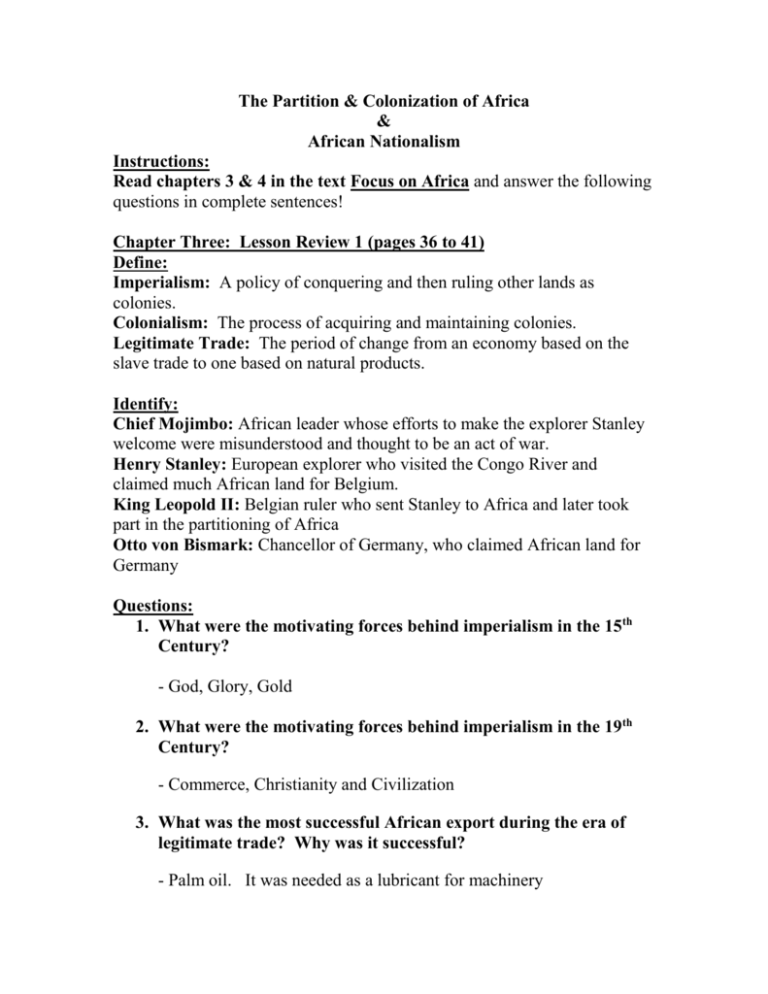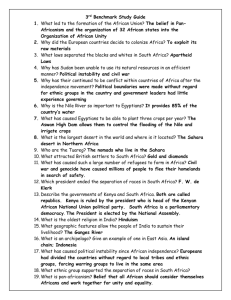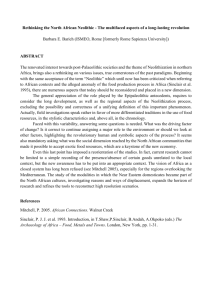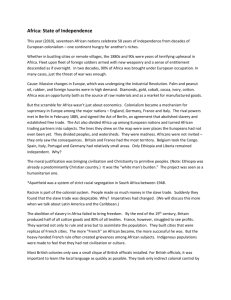The Partition & Colonization of Africa
advertisement

The Partition & Colonization of Africa & African Nationalism Instructions: Read chapters 3 & 4 in the text Focus on Africa and answer the following questions in complete sentences! Chapter Three: Lesson Review 1 (pages 36 to 41) Define: Imperialism: A policy of conquering and then ruling other lands as colonies. Colonialism: The process of acquiring and maintaining colonies. Legitimate Trade: The period of change from an economy based on the slave trade to one based on natural products. Identify: Chief Mojimbo: African leader whose efforts to make the explorer Stanley welcome were misunderstood and thought to be an act of war. Henry Stanley: European explorer who visited the Congo River and claimed much African land for Belgium. King Leopold II: Belgian ruler who sent Stanley to Africa and later took part in the partitioning of Africa Otto von Bismark: Chancellor of Germany, who claimed African land for Germany Questions: 1. What were the motivating forces behind imperialism in the 15th Century? - God, Glory, Gold 2. What were the motivating forces behind imperialism in the 19th Century? - Commerce, Christianity and Civilization 3. What was the most successful African export during the era of legitimate trade? Why was it successful? - Palm oil. It was needed as a lubricant for machinery 4. The partition of Africa among the various European powers is also known as what? Why? - Scramble for Africa, because of the speed with which the partition was carried out. 5. Explain the Berlin Act of 1885 in detail. - Conference to set down rules for European Nations to abide by when dividing Africa 1. 2. 3. 4. 5. King Leopold was to allow free trade for all European nations in the Congo, an area he already claimed. European countries were free colonize coastal territories that they already occupied and to extend their rule some distance inland. Each nation was required to notify all other signing countries when they occupied a new country. Treaties with African kings were to be accepted as valid titles to territories. European powers were to state their intent toward the African people. This included promises of protection, the suppression of slavery and to educate the natives. 6. Decode the political cartoon on page 38. - The snake is the Belgian King Leopold II. The Black man represents the people of Congo. The snake is strangling the black man, which represents how King Leopold ruled the Congo. 7. Map Study: Use the maps of Africa on pages 2 & 40 to answer the following questions: A. Which European country controlled the largest area of Africa? - France B. Which 2 countries of Africa were independent from outside control? - Ethopia and Liberia Chapter Three: Lesson Review 2 (pages 41 to 45) Define: Assimilation: A policy under which the colonized people were expected to assimilate the culture of the colonial ruler. Direct Rule: Colonial system in which the colony was ruled by the government of the occupying country Indirect Rule: Colonial system in which natives of the colony were permitted to form local governments, but these were in turn overseen by members of the occupying country Identify: Queen Mother Yaa Asatewa: Asante leader who stood up to the insensitive British, to preserve the dignity of her people. This occurred after a British soldier demanded to sit on the Asante golden stool. This stool was believed to be the soul of the Asante Nation and this was an insult to them. Cash Crops: Crops for exporting to make $ Questions: 1. Why didn’t the controlling countries encourage the production of crops for domestic use? What long-term effect did this have on many African nations? - They wanted the money from cash crops. - Many African nations were unable to produce enough food to feed their own people. - Since many African economies were based on one crop, the entire economy of a country failed because of lack of rain or the price of the crop fell on the world market. 2. What 3major social changes did colonialism cause? - Colonization brought about urbanization - It also brought about European-style educational opportunities for Africans. (These differed depending on which European country colonized the area) - Missionaries brought Christianity to many parts of Africa. 3. What were African independent churches known as? What was important about them? - Ethiopianist churches - They were a reaction against European domination and acknowledgement of the value of African culture and institutions. Chapter Four: Lesson Review 1 (pages 48 to 54) Define: Nationalism: A feeling of loyalty for one's own land and people Pan-Africanism: A movement that celebrated the kinship of all people of African descent and worked to improve their lives Identify: Negritude: A movement of French-speaking Africans to reject French assimilation in favour of their own African heritage Questions: 1. How did white settlement affect African’s ability to regain their freedom? - Whites who settled in Africa took and then held onto the best land, often fighting to retain it. Areas with large white populations were usually the hardest for African Nationalists to regain control of. 2. How did Marcus Garvey and W.E.B. DuBois influence the fight for independence in Africa? - MarcusGarvey : African American leader, advocate of 'Africa for Africans" - W.E.B. DuBois : African American professor and historian of West African medieval civilizations; advocated black social and economic independence Chapter Four: Lesson Review 2 (pages 55 to 57) Identify: African National Congress: South African group, founded in 1910, that hoped to form a society based on merit rather than on colour Question: 1. Why was Egypt’s early independence flawed. - Britain set up Fuad, who was of Turkish rather than African background, as king in 1922. When they granted Egypt independence, he was still king Chapter Four: Lesson Review 3 (pages 58-59) Identify: Atlantic Charter: Document signed by countries that fought the Axis Powers in WWII; contained language that suggested African countries should be allowed to govern themselves Fifth Pan-African Congress: Meeting of African countries in 1945 in which delegates, recalling the Atlantic Charter, vowed to work for freedom Questions: 1. Why did the fact that the United States and the Soviet Union became superpowers change colonialism? - Neither country supported British and French colonialism in Africa. 2. How were Britain and France forced to recognize the African demand for independence. - Mass protests, often led by a new generation of Western-educated Africans, forces colonial powers to address the question of independence. Chapter Four: Lesson Review 4 (pages 60 to 65) Define: Apartheid: South African system under which people were grouped according to race and all groups were put under white control. Identify: Freedom Charter: declaration that there can only be one unified South Africa under democratic, majority rule Sharpville: South African city where peaceful demonstrations against apartheid rules were killed by South African police South African Student Organization: organization formed to fight discrimination practices in the education system in South Africa. Soweto: Site of a demonstration in which demonstrating schoolchildren were shot down by police Questions: 1. In what ways did black South Africans resist Apartheid? - They were peaceful, but as the system became more cruel and oppressive, they turned to force and to the use of international pressure 2. Some former colonies gained their independence peacefully, while others much blood was shed. What factors created this difference? - The # of white settlers in an area and the general attitude of the colonial power









